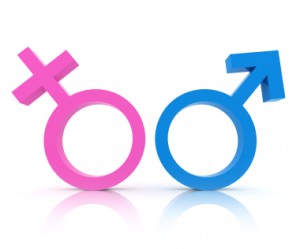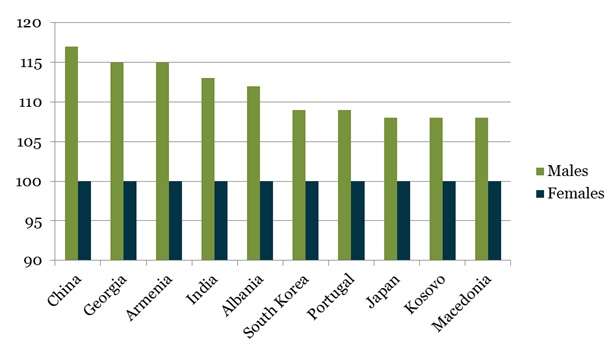History of sex-selection abortion and its impact today
 Every
year we celebrate International Women’s day – a day set aside to
celebrate females of all ages; newborns, young children, teenagers and
adults. A time to remember all of the struggles and inequalities
endured, as well as the great accomplishments achieved by women. But
with the triumph of so many rights for women comes a degrading act of
females harming other females through sex selective abortion. This
action does not signify progress nor does it protect women and girls.
Every
year we celebrate International Women’s day – a day set aside to
celebrate females of all ages; newborns, young children, teenagers and
adults. A time to remember all of the struggles and inequalities
endured, as well as the great accomplishments achieved by women. But
with the triumph of so many rights for women comes a degrading act of
females harming other females through sex selective abortion. This
action does not signify progress nor does it protect women and girls.This article is written to speak in behalf of those who cannot speak; for those girls who would have grown to be women; for those who would have had voices, but never will. It is written to speak in behalf of all of the females whose lives have been taken because they are girls.
Brief History and Current
Female infanticide has existed for centuries, but the problem became especially acute when ultrasound techniques for identifying the sex of an unborn child merged with abortion. When you combine ultrasound technology and readily-available and widely-accepted abortion with population control programs and attitudes, you have created the perfect storm for ending the lives of millions of unborn girls.
It is estimated that 160 million females are “missing” because of sex selective abortion; their lives have been claimed and cut short merely because of the fact that they were girls. This alarming number is equivalent to annihilating all of the females living in the United States alone! (US Census of 2010)
China’s one-child policy has greatly increased the disparity between the number of male and female births. Since implementation of the policy over three decades ago, the ratios between male and female births has steadily increased. In 1979 – the year the policy was initiated – there were 106 boys born for every 100 girls – not far from the “natural” sex ratio of 105 boys born for every 100 girls. Currently, the sex ratio in China is around 117 boys born for every 100 girls. In some areas of the country, it has risen to as high as 140 boys being born for every 100 girls.
While Asian populations have a substantially higher number of those participating in the killing of their unborn daughters, sex selective abortion happens in other cultures, as well.
As you can see, this graph depicts a small portion of the many countries that have significant sex ratio imbalances.
Sex Ratio, Children under 15 Years of Age, By Country
(CIA World Factbooks)
With China at the highest sex ratio, it is closely followed by the
Countries of Georgia and Armenia, whose sex ratio is 115 males born for
every 100 females. Following these Countries are India and Albania with
113 and 112 boys born for every 100 girls, respectively. And while the
sex ratios found in South Korea, Portugal, Japan, Kosovo and Macedonia
are closer to the “natural” sex ratio, their imbalance of males to
females under the age of 15 is still high enough to take note of. (CIA World Factbooks)(CIA World Factbooks)
Negative Impacts
Some have no problem with sex selective abortion. After all, abortion, some say, is a “right.” But the negative implications and consequences of sex selective abortion are numerous:
The unborn girl is the first and greatest victim of sex selective abortion. Some may oppose this by saying that an unborn fetus has no “human status.” But when the motivation behind an abortion is to eliminate a fetus for the sole reason of that fetus having a gender – that of a female – the foundation of this argument becomes insubstantial. As former abortionist Bernard N. Nathanson, M.D., shared, “abortion must be seen as the interruption of a process which would otherwise have produced a citizen of the world.” (New England Journal of Medicine, 1974)
Sex selective abortion also raises this question: What happens when millions of men cannot find women to marry? Some 24 million Chinese men of marrying age will find themselves lacking wives by 2020. ”Bare branches:” this is how the Chinese refer to Chinese males who will never have families because they cannot find spouses. It is an apt metaphor: “bare branches” – unmarried men who will have nothing attached to them. There will be no wife, no children. Researchers offer some insight into the common characteristics of these men:
- Belong predominantly to the lowest socioeconomic class
- More likely to be underemployed or unemployed
- Transient with few ties to the community
- Transient males commit proportionately more violence than non-transient males
- Live and socialize with other “bare branches”, creating distinctive bachelor subcultures
- Commit more violence – often under the influence of alcohol and certain drugs
- Predisposed to risk taking (Valerie M. Hudson and Andrea M. den Boer, 2004 “Bare Branches”)
Studies have also been conducted to examine the behaviors of men when gender imbalance exists. Such studies have shown that among these men, there is a statistically significant increase of mental illness, socially disruptive behavior, lower self-esteem, depression, and suicidal thoughts compared to men who are married. (Beyond Buoying the Boys)
Along with the decrease of women comes an increase in demand for trafficked brides and an increase in prostitution. Contrary to what you may assume, being part of a female minority population does not make you a coveted and adored prize, but a commodity to be exploited. As boldly and truthfully put by Reggie Littlejohn, “Women[, both born and unborn,] should not be treated this way. This is not a political issue. Women’s rights are human rights.” (Women’s Rights Without Frontiers)
Fewer women means fewer children being born. Some may view population reduction as a positive thing, but in many countries, declining population poses significant problems. Whatever your view, thinning a population by eliminating girls simply because they are girls is sex discrimination and gender-based violence at its worst. It should not be tolerated – no matter your goal.
Conclusion
We, as women, have persevered in fighting for our rights, but I do not believe we have fought enough. We have seen great success in bringing ourselves great rights, opportunities, and promising futures, but have we done enough to give that to others of our own sex? If feminism holds the belief that women should have a right to speak, vote, hold jobs, and make choices for themselves, should it not also include the belief that women should be given a chance at life?
Source: LiveAction News










No comments:
Post a Comment